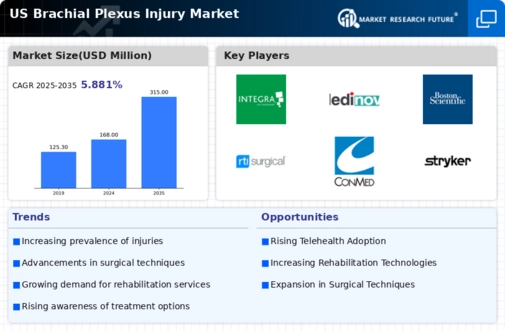Growing Awareness and Advocacy
Awareness campaigns and advocacy efforts surrounding brachial plexus injuries are gaining momentum, which is positively impacting the brachial plexus-injury market. Organizations dedicated to educating the public and healthcare providers about the causes, symptoms, and treatment options for these injuries are emerging. This increased awareness is likely to lead to earlier diagnosis and intervention, which can significantly improve patient outcomes. Moreover, advocacy groups are pushing for better insurance coverage and access to specialized care, which could further stimulate market growth. The collective efforts of these organizations are fostering a more informed patient population, thereby driving demand for services and products within the brachial plexus-injury market.
Technological Innovations in Treatment
Technological advancements in treatment modalities are significantly influencing the brachial plexus-injury market. Innovations such as minimally invasive surgical techniques and enhanced imaging technologies are improving diagnostic accuracy and treatment outcomes. For instance, the introduction of robotic-assisted surgeries has shown promising results in reducing recovery times and improving functional outcomes for patients. Furthermore, the market is witnessing the development of advanced rehabilitation devices that facilitate better recovery processes. As these technologies become more accessible, they are likely to attract investment and research, thereby propelling the growth of the brachial plexus-injury market. The integration of telemedicine for follow-up care also appears to enhance patient engagement and satisfaction.
Rising Incidence of Brachial Plexus Injuries
The brachial plexus-injury market is experiencing growth due to an increase in the incidence of brachial plexus injuries, particularly among newborns during delivery. According to recent data, approximately 1-2 out of every 1,000 births result in a brachial plexus injury, leading to a heightened demand for specialized medical interventions. Additionally, sports-related injuries are contributing to this trend, as athletes in contact sports are at a higher risk. This rising incidence necessitates advancements in treatment options and rehabilitation services, thereby driving the brachial plexus-injury market. The increasing awareness of these injuries among healthcare professionals and the general public further amplifies the need for effective solutions, indicating a robust market potential.
Expansion of Multidisciplinary Care Approaches
The brachial plexus-injury market is witnessing a shift towards multidisciplinary care approaches, which are becoming increasingly recognized as essential for optimal patient outcomes. This model integrates various healthcare professionals, including surgeons, physical therapists, and occupational therapists, to provide comprehensive care for individuals with brachial plexus injuries. Such collaboration is likely to enhance the effectiveness of treatment plans and rehabilitation strategies, thereby improving recovery rates. As healthcare systems adopt this approach, the demand for coordinated services is expected to rise, contributing to the growth of the brachial plexus-injury market. This trend reflects a broader movement towards holistic patient care, which may redefine treatment paradigms in the future.
Increased Funding for Research and Development
The brachial plexus-injury market is benefiting from increased funding directed towards research and development initiatives. Government and private sector investments are focusing on understanding the complexities of brachial plexus injuries and exploring novel therapeutic approaches. In recent years, funding for clinical trials and innovative treatment methodologies has surged, with estimates suggesting a growth rate of over 10% in R&D budgets allocated to this area. This influx of capital is likely to accelerate the development of new therapies and improve existing treatment protocols, thereby enhancing the overall market landscape. As research progresses, it may lead to breakthroughs that could redefine standards of care in the brachial plexus-injury market.

















Leave a Comment